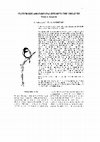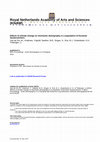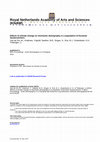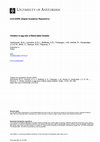Papers by Joost Tinbergen
Ardea, Jul 26, 2014
BioOne Complete (complete.BioOne.org) is a full-text database of 200 subscribed and open-access t... more BioOne Complete (complete.BioOne.org) is a full-text database of 200 subscribed and open-access titles in the biological, ecological, and environmental sciences published by nonprofit societies, associations, museums, institutions, and presses.
Ardea, Apr 1, 2012
BioOne Complete (complete.BioOne.org) is a full-text database of 200 subscribed and open-access t... more BioOne Complete (complete.BioOne.org) is a full-text database of 200 subscribed and open-access titles in the biological, ecological, and environmental sciences published by nonprofit societies, associations, museums, institutions, and presses.
... prisoner (oystercatchers again) by Bruno Ens and Marcel Kersten, Winter hazards for waders: c... more ... prisoner (oystercatchers again) by Bruno Ens and Marcel Kersten, Winter hazards for waders: cold snaps and mortality peaks (more oystercatchers) by Jan Hulscher, From individual to population and back again (barnacles and oyster-catchers) by Jaap van der Meer, and Do ...

Ardea, 1997
We experimentally reduced clutch size of Great Tits Parus major to investigate the effects on par... more We experimentally reduced clutch size of Great Tits Parus major to investigate the effects on parental care (including Daily Energy Expenditure, DEE, measured with doubly labelled water), and the relationship between DEE and the residual reproductive value. The length of a working day was not affected, but the nestling phase was 0.7 days (4%) shorter in experimental clutches. Males fed reduced broods at a lower rate, but DEE and mass (loss) were not significantly affected by the experiment. However, male DEE was positively correlated with feeding frequency, and this relationship did not differ between control and experimental cJ cJ. This suggests that the experiment resulted in a slight reduction in male DEE, and lack of statistical significance can be attributed to the power of the test applied. Females fed reduced broods at a lower rate, but female DEE and mass (loss) were not affected by the clutch size manipulation. Female DEE was not correlated with feeding frequency, the original number of eggs in the nest or the actual number of young. The division of labour (feeding rate, DEE) was not affected by the clutch size manipulation. Female DEE was significantly higher than male DEE, and this could be caused by the fact that only the 9 roosts with the young. There was no consistent relationship between DEE and parental survival or future reproductive success. Since the experimental reduction in clutch size led to an increase in residual reproductive value (more second clutches), but not to a decrease in DEE, this costs of reproduction is apparently not contingent on increased rate of energy turnover. It is suggested that birds with equal DEE may differ in their residual reproductive value as a consequence of variation in energy allocation between reproductive effort and e.g. aspects of physiological maintenance and repair.
Ibis, Dec 26, 2014
Take-down policy If you believe that this document breaches copyright please contact us providing... more Take-down policy If you believe that this document breaches copyright please contact us providing details, and we will remove access to the work immediately and investigate your claim.

Effects of climate change on stochastic demography in a population of Eurasian Oystercatchers. In... more Effects of climate change on stochastic demography in a population of Eurasian Oystercatchers. In BOU Proceedings-Avian Demography in a Changing http://www.bou.org.uk/bouproc-net/avian-demography/van-depol-et-al.pdf General rights Copyright and moral rights for the publications made accessible in the public portal are retained by the authors and/or other copyright owners and it is a condition of accessing publications that users recognise and abide by the legal requirements associated with these rights. • Users may download and print one copy of any publication from the KNAW public portal for the purpose of private study or research. • You may not further distribute the material or use it for any profit-making activity or commercial gain. • You may freely distribute the URL identifying the publication in the KNAW public portal. Take down policy If you believe that this document breaches copyright please contact us providing details, and we will remove access to the work immediately and investigate your claim.

IIn vertebrates, darker individuals are often found to be more active and willing to take risks (... more IIn vertebrates, darker individuals are often found to be more active and willing to take risks (representing characteristics of a ‘proactive’ coping style), whereas lighter individuals are instead more cautious and less active (representing characteristics of a ‘reactive’ coping style). It is thus generally expected that melanin-based colouration and proactivity form a suite of positively integrated traits at the among-individual level. Here we use a multi-generational pedigree of free-living great tits (Parus major) to partition variation in, and the correlation between, melanin-based breast stripe (‘tie’) size and exploration behaviour (a proxy for coping style) into its among- and within-individual components. We show that both traits harbour heritable variation. Against predictions, tie size and speed of exploration were negatively correlated at the among-individual level due to the combined influences of permanent environmental and additive genetic effects. By contrast, the two traits were weakly positively correlated within individuals (i.e., individuals increasing in tie size after moult tended to become more explorative). The patterns of among-individual covariance were not caused by correlational selection as we found additive and opposite selection pressures acting on the two traits. These findings imply that testing hypotheses regarding the existence of a ‘syndrome’ at the among-individual level strictly requires variance partitioning to avoid inappropriate interpretations as the negative ‘unpartitioned’ phenotypic correlation between exploration and tie size resulted from counteracting effects of within- and among-individual correlations. Identifying sources and levels of (co)variation in phenotypic traits is thus critical to our understanding of biological patterns and evolutionary processes
The datafile is an excel file containing 5 sheets with the data used for the article. Please read... more The datafile is an excel file containing 5 sheets with the data used for the article. Please read the accompanying text file 'README.txt' for more information on the datasets and the meaning of the columns
Estimates of model parameters used in stochastic population model.

Effects of climate change on stochastic demography in a population of Eurasian Oystercatchers. In... more Effects of climate change on stochastic demography in a population of Eurasian Oystercatchers. In BOU Proceedings-Avian Demography in a Changing http://www.bou.org.uk/bouproc-net/avian-demography/van-depol-et-al.pdf General rights Copyright and moral rights for the publications made accessible in the public portal are retained by the authors and/or other copyright owners and it is a condition of accessing publications that users recognise and abide by the legal requirements associated with these rights. • Users may download and print one copy of any publication from the KNAW public portal for the purpose of private study or research. • You may not further distribute the material or use it for any profit-making activity or commercial gain. • You may freely distribute the URL identifying the publication in the KNAW public portal. Take down policy If you believe that this document breaches copyright please contact us providing details, and we will remove access to the work immediately and investigate your claim.

Journal of Biological Rhythms, 2018
111 The fields of chronobiology and physiological ecology lost a prominent member when Serge Daan... more 111 The fields of chronobiology and physiological ecology lost a prominent member when Serge Daan, Emeritus Professor at the University of Groningen, passed away on 9 February 2018. Serge was a clever and critical researcher who inspired and trained many of us. He made seminal discoveries in hibernation research, ecological energetics, behavioral biology, sleep research, and sex-ratio adaptation. Serge was born in 1940, in the historic windmill “De Plasmolen” in Mook, Limburg, the Netherlands. In 1944, during the Second World War liberation, the Daan family fled from the Plasmolen only hours before it was shelled by American troops. After the war, the family moved to the estate “Het Schol” near Deventer, where Serge grew up with seven brothers and sisters. The family had a great interest in biology, and together the children built an impressive collection of skulls for their museum. Many visitors may remember part of this collection displayed in the hall of Serge’s house “Villa Later” in Paterswolde. Serge studied biology at the University of Amsterdam and obtained his master’s degree in 1966. During his studies he worked with evolutionary biologist Dick Hillenius at the Zoological Museum Amsterdam, which was at the time a meeting place of biologists, artists, writers, and poets. Serge expanded the museum collections by catching amphibians in southern Limburg, using his Harley Davidson as a field vehicle. In Greece he collected reptiles, and to his surprise a newly discovered Agama lizard subspecies was named after him: Agama stellio daani (Beutler and Frør, 1980). Unwilling to spend the rest of his life in dusty museums, Serge returned his PhD grant to the Dutch Science Foundation and instead obtained stipends to investigate hibernation with Prof. dr. Punt in 1968 (Daan, 1973a; PhD cum laude, University of Amsterdam). This venture took Serge back to southern Limburg, where he discovered that hibernating bats would save energy by moving to colder parts of the cave (Daan, 1973b). To test whether this behavior was a temperature response, he carried large blocks of ice into the cave to attract hibernating bats. The result of this experiment was that Serge caught pneumonia, but it also represents a landmark: Serge had changed from a descriptive taxonomist to an experimental biologist. Activity patterns during hibernation were further studied in garden dormice in the laboratory. Serge described that euthermic arousals clearly followed a circadian pattern, interrupted by multiday torpor (Daan, 1973c). These patterns were the first free-running circadian data collected by Serge. They sparked his interest in biological rhythms, further boosted by Mike Menaker’s early publication on circadian rhythms in hibernating bats (Menaker, 1959). It was many years later, in 2009, when Serge, as faculty Dean, was able to show his gratitude and admiration to Mike Menaker by awarding him an honorary professorship at the University of Groningen: “For a generation of researchers into the biological clock, including those in Groningen, Michael Menaker is the giant on whose shoulders they stand.” Serge wanted to learn more about the emerging field of circadian rhythms by visiting Jürgen Aschoff. In one day they wrote a successful Humboldt postdoctoral fellowship application allowing Serge to work with Aschoff at the famous Max Planck Institute 768594JBRXXX10.1177/0748730418768594Journal Of Biological Rhythms research-article2018
is P ie rsm a & Jo o st M. T inb erg en "The relation of theory to experiment in biology has been... more is P ie rsm a & Jo o st M. T inb erg en "The relation of theory to experiment in biology has been an uneasy one. The word "theoretical" has generally had perjorative connotations, and the right to the orize was the reward for years o f laboratory and field work. In fields where progress depends mostly on the refinement of technique in order to facilitate more accurate description, this perhaps did not matter too much, but other areas suf fered from an indigestion o f facts, while data was collected without reference to problems. In these circumstances, theoretical work often diverged too far from life and became exercises in mathematics inspired by biology rather than an analysis o f living systems.

Ardea, Jan 22, 2020
As is the case for most avian species, there is considerable variation in the egg size of Contine... more As is the case for most avian species, there is considerable variation in the egg size of Continental Black-tailed Godwits Limosa l. limosa breeding in The Netherlands. It is interesting that egg size has costs and benefits yet varies considerably at the population level. To better understand this variation in egg size, we tested its relationship to a suite of individual and environmental factors. We found that egg size can decrease up to 2.8% throughout a breeding season and that egg size increases with clutch size by 1.4% with each additional egg in the clutch. Female body mass and body size explained 5% of the total variation in egg size observed across the population. Furthermore, females wintering south of the Sahara laid 3% smaller eggs than those wintering north of the Sahara. We also found that egg size increases with age, which may indicate age-related differences in the endogenous and/or exogenous conditions of females. The variation in egg size was, however, mostly the result of consistent differences among individuals across years (repeatability = 0.60). A comparison of daughters with mothers suggested that most of this individual repeatability reflects heritable variation (heritability = 0.64). The actual individual traits that underlie this heritable variation among individuals remain mostly undetermined. Smaller eggs did have a slightly lower chance of hatching, but we found no relationship between egg size and chick survival. Finally, nest and chick survival were strongly correlated with lay date. Thus, in Black-tailed Godwits, lay date may actually reflect a female's endogenous and/or exogenous condition at the moment of egg-laying. This finding may be general across birds, since food supplementation experiments usually result in advanced laying and larger clutch sizes rather than in larger eggs.
Ardea, Jan 15, 2014
BioOne Complete (complete.BioOne.org) is a full-text database of 200 subscribed and open-access t... more BioOne Complete (complete.BioOne.org) is a full-text database of 200 subscribed and open-access titles in the biological, ecological, and environmental sciences published by nonprofit societies, associations, museums, institutions, and presses.

Uploads
Papers by Joost Tinbergen